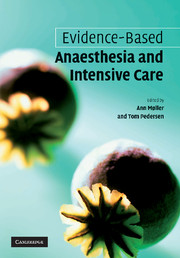Book contents
- Frontmatter
- Contents
- Foreword
- Contributors
- 1 Introducing evidence-based anaesthesia
- 2 How to define the questions
- 3 Developing a search strategy, locating studies and electronic databases
- 4 Retrieving the data
- 5 Critical appraisal and presentation of study details
- 6 Outcomes
- 7 The meta-analysis of a systematic review
- 8 Bias in systematic reviews: considerations when updating your knowledge
- 9 The Cochrane Collaboration and the Cochrane Anaesthesia Review Group
- 10 Integrating clinical practice and evidence: how to learn and teach evidence-based medicine
- 11 Involving patients and consumers in health care and decision-making processes: nothing about us without us
- 12 Evidence-based medicine in the Third World
- 13 Preoperative anaesthesia evaluation
- 14 Regional anaesthesia versus general anaesthesia
- 15 Fluid therapy
- 16 Antiemetics
- 17 Anaesthesia for day-case surgery
- 18 Obstetrical anaesthesia
- 19 Anaesthesia for major abdominal and urological surgery
- 20 Anaesthesia for paediatric surgery
- 21 Anaesthesia for eye, ENT and dental surgery
- 22 Anaesthesia for neurosurgery
- 23 Cardiothoracic anaesthesia and critical care
- 24 Postoperative pain therapy
- 25 Critical care medicine
- 26 Emergency medicine: cardiac arrest management, severe burns, near-drowning and multiple trauma
- Glossary of terms
- Index
22 - Anaesthesia for neurosurgery
Published online by Cambridge University Press: 05 September 2009
- Frontmatter
- Contents
- Foreword
- Contributors
- 1 Introducing evidence-based anaesthesia
- 2 How to define the questions
- 3 Developing a search strategy, locating studies and electronic databases
- 4 Retrieving the data
- 5 Critical appraisal and presentation of study details
- 6 Outcomes
- 7 The meta-analysis of a systematic review
- 8 Bias in systematic reviews: considerations when updating your knowledge
- 9 The Cochrane Collaboration and the Cochrane Anaesthesia Review Group
- 10 Integrating clinical practice and evidence: how to learn and teach evidence-based medicine
- 11 Involving patients and consumers in health care and decision-making processes: nothing about us without us
- 12 Evidence-based medicine in the Third World
- 13 Preoperative anaesthesia evaluation
- 14 Regional anaesthesia versus general anaesthesia
- 15 Fluid therapy
- 16 Antiemetics
- 17 Anaesthesia for day-case surgery
- 18 Obstetrical anaesthesia
- 19 Anaesthesia for major abdominal and urological surgery
- 20 Anaesthesia for paediatric surgery
- 21 Anaesthesia for eye, ENT and dental surgery
- 22 Anaesthesia for neurosurgery
- 23 Cardiothoracic anaesthesia and critical care
- 24 Postoperative pain therapy
- 25 Critical care medicine
- 26 Emergency medicine: cardiac arrest management, severe burns, near-drowning and multiple trauma
- Glossary of terms
- Index
Summary
The practice of neuroanaesthesia is unique in that the target organ of both the surgeon and the anaesthetist is one and the same. Thus, the surgical goals have a profound impact on the constraints that the anaesthesiologist must work within. In order to appropriately anaesthetise the patient for neurosurgery, an understanding of the interrelationships of neurophysiology, pathophysiology and pharmacology is important. This chapter will review: (1) basic neurophysiological principles, (2) specific approaches to the management of intracranial pressure (ICP) as they relate to clinical neuroanaesthesia, and (3) intraoperative management of the patient with a supratentorial mass lesion.
Basic principles of neurophysiology
There are six interrelated components that are important to the practice of neuroanaesthesia. They are maintenance of cerebral perfusion pressure (CPP), cerebral blood flow (CBF), cerebral blood volume (CBV), intracranial pressure (ICP), CO2 responsiveness (CO2R) and cerebral oxygen metabolism (CMRO2).
Cerebral perfusion pressure
CPP is the difference between mean arterial pressure (MAP) and intracranial pressure (ICP) (CPP = MAP – ICP), although in the occasional patient where central venous pressure (CVP) is higher than ICP, CPP = MAP – CVP. Both intracranial pathology and drugs may compromise CPP through effects on MAP and/or ICP. CPP is usually >70mmHg. An optimal CPP has not been defined but in the context of head trauma, a CPP <60 is associated with a poorer outcome; a benefit of higher CPP has not been shown [1].
- Type
- Chapter
- Information
- Evidence-based Anaesthesia and Intensive Care , pp. 282 - 292Publisher: Cambridge University PressPrint publication year: 2006

